Clear documentation separates high-performing marketing teams from those stuck in constant reactive mode. Studies show that having well-structured strategies, guidelines, and processes written down leads to significantly higher ROI and more consistent campaign success.
Key Components for Marketing Success:
- Strategy Documentation: Written marketing strategies help teams operate from a unified playbook, making it 414% more likely you’ll achieve your goals compared to undocumented approaches.
- Process Definition: Clear documentation of workflows, guidelines and best practices reduces errors by 43% and speeds up campaign execution by cutting confusion and back-and-forth.
- Measurement Framework: Companies with documented metrics and KPIs are 3x more likely to consistently hit their targets versus those tracking metrics ad hoc.
- Brand Consistency: Organizations with documented brand guidelines see 23% higher revenue compared to those without standardized branding rules.
- Knowledge Management: Properly documented marketing processes reduce new hire ramp-up time by 60% while preserving institutional knowledge as teams evolve.
These proven documents, templates and frameworks form the foundation of effective marketing execution. Let’s examine each one in detail to understand how they work together to drive measurable results.
10+ Marketing Documents You Need
Well-organized marketers are 674% more likely to report success than those working without proper documentation. These core documents eliminate guesswork and random tactics by providing clear frameworks for everything from winning client proposals to measuring campaign results.
Each template and guide in this collection has been proven to help marketing teams consistently hit their goals.
| Document | Description |
| Marketing Proposal | Outlines how you'll execute marketing activities and what results you'll deliver. Tells a clear story about your marketing plan. |
| Marketing Objectives | Converts business goals into specific marketing outcomes with exact numbers and timeframes. |
| Marketing Strategy | Defines how your business will reach and persuade customers to buy your products or services. |
| Marketing Plan | Turns strategy into concrete actions, detailing activities, timing, and resources needed. |
| Marketing Playbook | Documents standard processes, guidelines, and best practices that act as a reference guide. |
| Marketing Guidelines | Creates consistency in how your brand appears and communicates across all channels. |
| Customer Personas | Creates detailed profiles of your ideal customers based on actual customer data. |
| Social Media Content Calendar | Maps out when and what you'll post across social media channels to ensure consistency. |
| Market Analysis | Evaluates total market size, customer needs, and competition to shape marketing decisions. |
| Email Newsletter Template | Ensures newsletters maintain consistent design and structure across all sends. |
1) Marketing Proposal
A marketing proposal outlines exactly how you’ll execute marketing activities and what results you’ll deliver. This document needs to tell a clear story about your marketing plan, whether you’re seeking internal approval or pitching to potential clients.
Core Components of Marketing Proposal
Every effective marketing proposal follows a proven structure that guides readers through your plan from start to finish.
Each section below serves a distinct purpose in telling your story and demonstrating the value of your proposed approach.

- Executive Summary
The executive summary gives readers a complete overview of your marketing plan in one page. Rather than making vague promises, focus on specific actions and outcomes. Write this section after completing the rest of the proposal, pulling in the key points from each section.
Your summary needs to clearly state the marketing challenge, your solution, and expected results. For example: “This three-month social media campaign will increase brand awareness among women aged 25-34 through daily Instagram content and influencer partnerships, growing our following from 10,000 to 25,000 followers.”
-
- Market Analysis
The market analysis shows you’ve done your research and understand both the business and its customers. Start by examining current market conditions and customer behavior patterns. Then analyze competitors to identify gaps and opportunities.
Your research findings should directly connect to your proposed strategy. For instance, if you discover that 70% of target customers prefer video content over text, use this insight to justify a video-first approach in your tactics.
Key areas to research include:
- Customer preferences and behaviors
- Competitor strategies and market position
- Industry trends affecting the business
- Current marketing performance
-
- Proposed Strategy
Your strategy section must explain exactly what actions you’ll take and why they’ll work. Begin by outlining your overall approach, then break down specific tactics for each marketing channel.
For example, if you’re planning a product launch, explain how email marketing, social media, and paid advertising will work together. Show how each channel supports the others - like using social media to grow your email list, then using email to drive sales.
Include details about:
- Content themes and messaging
- Channel-specific tactics
- Campaign timing and frequency
- Content distribution methods
-
- Budget Breakdown
The budget section answers the question “what will this cost?” Break down expenses by channel and activity type, showing both one-time and ongoing costs. Explain what each cost covers and why it’s necessary.
For instance, don’t just list “Social Media: $2,000.” Instead, break it down to show that this covers content creation ($1,200), scheduling tools ($300), and paid promotion ($500). This level of detail helps readers understand exactly where money will go.
-
- Timeline and Implementation
Create a clear schedule showing when each element of your plan will happen. Start with the major phases of your project, then break down specific activities within each phase.
Your timeline should flow logically from preparation through execution to measurement. Include check-in points where you’ll review progress and make adjustments based on results.
-
- Success Metrics
End your proposal by defining exactly how you’ll measure success. Connect each metric to a business goal and set specific targets. For example, instead of just tracking “increased website traffic,” specify “grow monthly organic traffic from 50,000 to 75,000 visitors within six months.”
For each metric, explain:
-
- What you’ll measure
- Your target numbers
- How often you’ll report results
- What success looks like
Keep your proposal focused on what matters - specific actions and measurable results. Avoid technical jargon and marketing buzzwords. Instead, write clearly about what you’ll do and what results the reader can expect. Make it easy for anyone to understand your plan and why it will work.
2) Marketing Objectives
Marketing objectives translate business goals into specific marketing outcomes. Unlike general aims like “grow the business,” marketing objectives must include exact numbers, clear timeframes, and measurable results that show progress toward business targets.
Setting Clear Marketing Objectives
Start by examining your overall business goals. If your company wants to increase market share by 20% this year, your marketing objectives need to outline exactly how marketing activities will help achieve this growth. Each objective should specify what you’ll measure, what numbers you’ll target, and when you’ll achieve them.
For example, instead of setting a vague goal like “get more social media followers,” create a specific objective: “Increase Instagram followers from 5,000 to 15,000 by December through daily educational content and weekly live Q&A sessions.”
Types of Marketing Objectives
Your marketing objectives generally fall into four main categories, each targeting a different aspect of business growth. Let’s examine each type and how to set specific targets for measuring success.
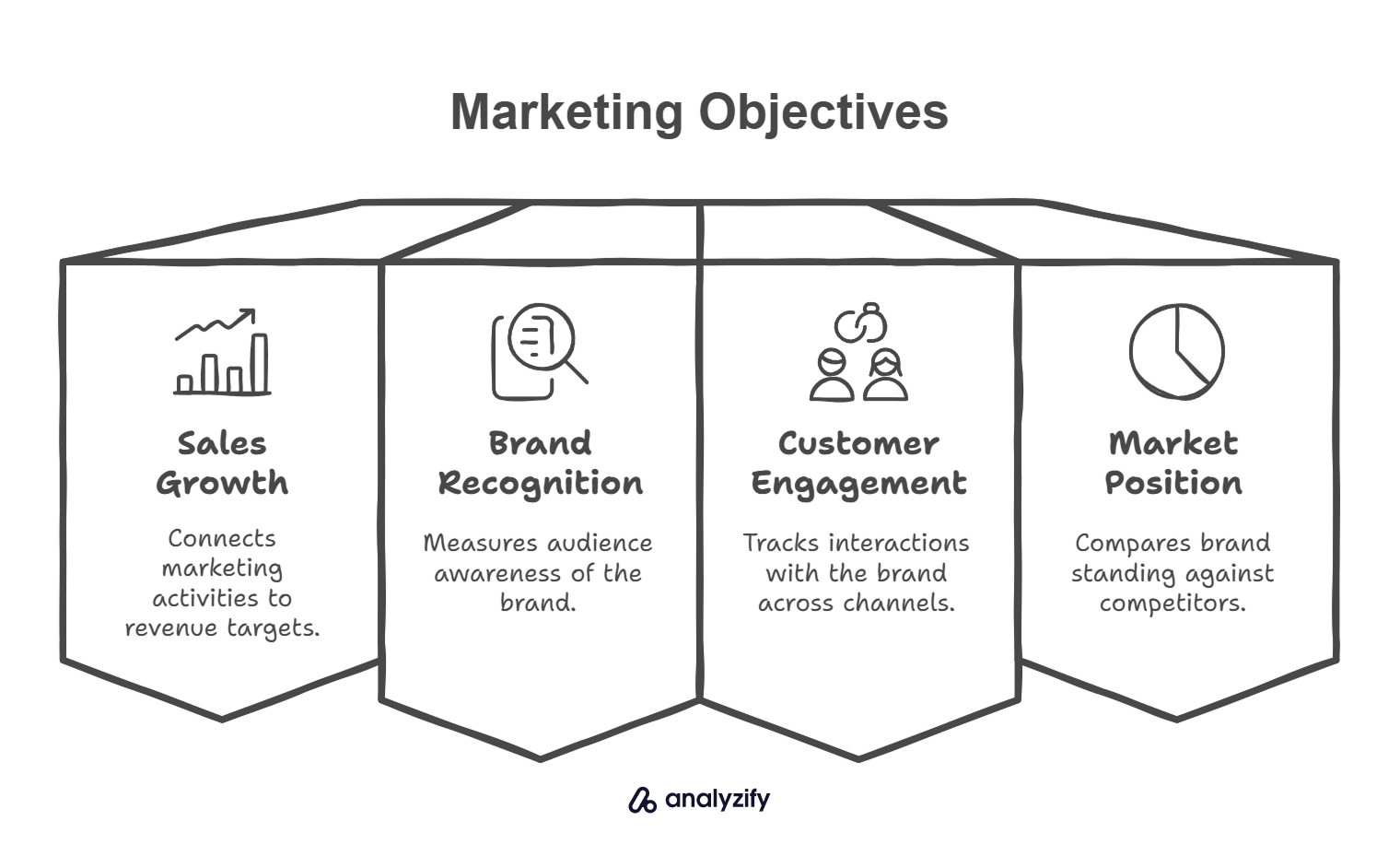
-
- Sales Growth
Sales objectives connect marketing activities directly to revenue. Begin by analyzing your current sales figures and conversion rates. Then set specific targets for improvement through marketing activities.
A well-written sales objective might read: “Increase monthly sales revenue from $50,000 to $75,000 by launching a customer referral program and automated email nurture sequence by Q3.”
Common metrics for sales objectives include:
- New customer acquisition
- Average order value
- Customer lifetime value
- Sales conversion rates
-
- Brand Recognition
Brand awareness objectives measure how well your target audience knows and remembers your brand. These objectives should focus on specific aspects of brand recognition that you can measure over time.
An effective brand awareness objective might state: “Achieve 85% brand recognition among target customers in our local market through consistent content marketing and community events by year-end.”
-
- Customer Engagement
Customer engagement objectives track how deeply people interact with your brand across different channels. These objectives help you measure the effectiveness of your content and communication strategies.
Write engagement objectives that specify exactly what actions you want customers to take. For instance: “Increase email newsletter engagement by achieving a 25% click-through rate through personalized content and segmentation by Q4.”
-
- Market Position
Market position objectives focus on how you compare to competitors in your industry. These objectives should reflect realistic market share targets based on your current position and available resources.
Create market position objectives that specify which segment of the market you’re targeting and how you’ll capture it. For example: “Become the top-rated wedding photographer in Seattle through consistent 5-star reviews and featured placement in three major wedding publications by June.”
Measuring Progress
Create a clear system for tracking progress toward your objectives. Set up monthly review meetings to examine your metrics and determine if you’re on track. When reviewing performance:
- Compare current numbers to your targets
- Identify which tactics are working best
- Adjust strategies that aren’t performing
- Document learnings for future planning
Your objectives should remain fixed unless major market changes occur, but your tactics can evolve based on what the data shows is working best.
3) Marketing Strategy
A marketing strategy defines how your business will reach and persuade customers to buy your products or services. Unlike a collection of random marketing activities, a strategy provides a clear roadmap that guides all your marketing decisions and actions.
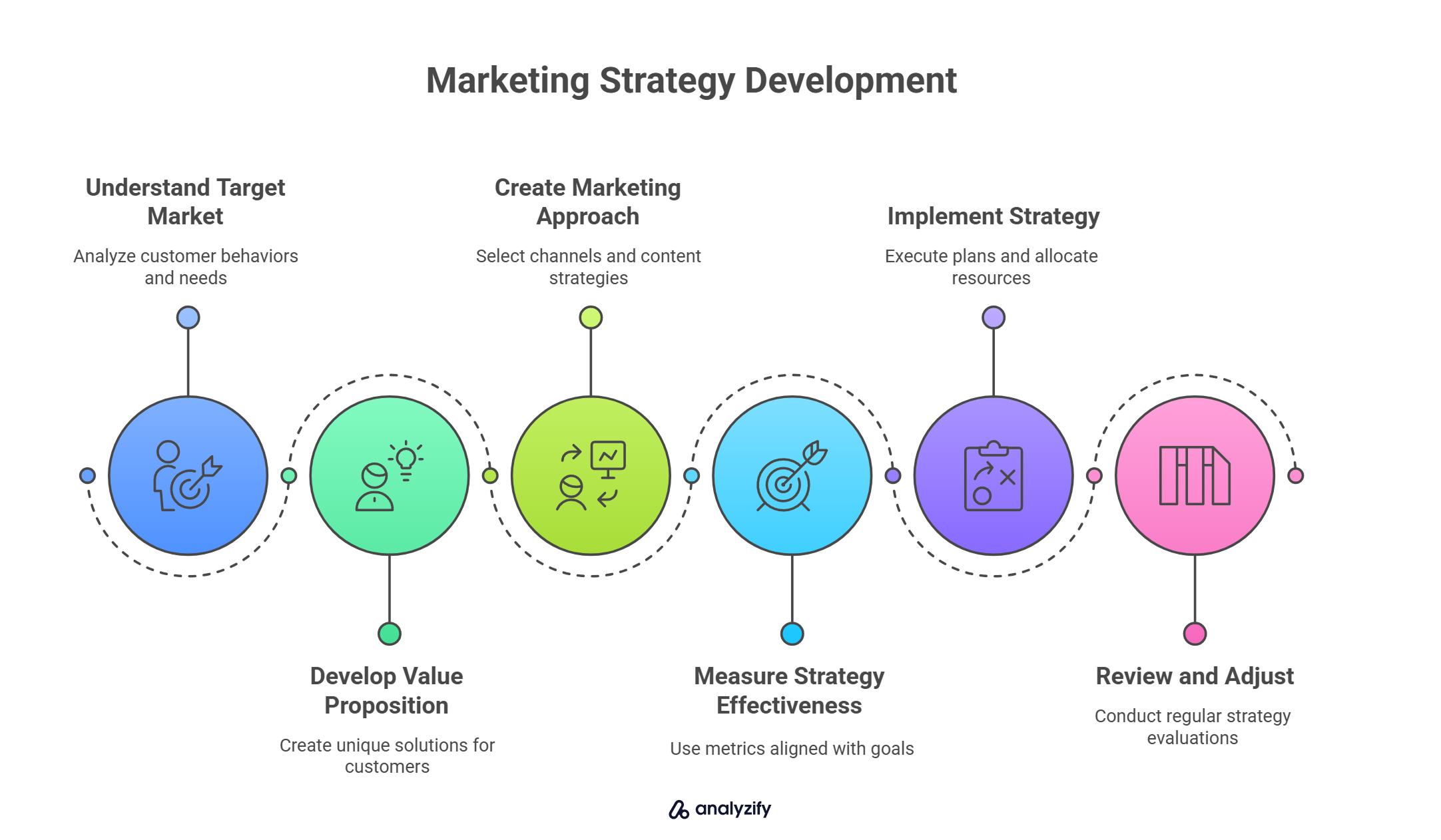
Understanding Your Target Market
Before developing tactics, you must understand exactly who you want to reach. Study your current customers and market research to identify patterns in who buys from you and why they choose your business.
Your target market analysis should examine real customer behaviors and needs. For instance, if you sell organic skincare products, you might discover your core customers are health-conscious women aged 25-40 who research ingredients carefully before making purchases.
Key areas to analyze in your target market include:
- Purchase behaviors and decision factors
- Common problems they’re trying to solve
- Where they seek information
- What influences their buying choices
Developing Your Value Proposition
Your value proposition explains why customers should choose you over competitors. Think about how you solve customer problems in unique ways. A strong value proposition focuses on specific benefits rather than general claims.
Consider a meal delivery service. Instead of saying “we make dinner easier,” their value proposition might be: “Fresh, pre-portioned ingredients and 20-minute recipes delivered weekly, helping busy professionals eat healthy home-cooked meals without grocery shopping or meal planning.”
Creating Your Marketing Approach
Your marketing approach outlines how you’ll reach and engage customers. This includes choosing the right channels, creating effective content, and deciding how you’ll measure success.
Channel selection should be based on where your target audience spends time. If your research shows your customers prefer to learn about products through video content, your strategy might focus heavily on YouTube and social media video rather than traditional advertising.
Your content approach needs to align with how customers make buying decisions. For example, if customers typically research extensively before buying, create detailed educational content that helps them evaluate options and make informed choices.
Measuring Strategy Effectiveness
Set up clear ways to measure if your strategy is working. Choose metrics that directly connect to business goals rather than vanity metrics that look good but don’t drive results.
Key metrics might include:
- Customer acquisition cost
- Conversion rates
- Customer lifetime value
- Revenue from marketing campaigns
Implementing Your Strategy
Create a clear plan for putting your strategy into action. Start with your most important priorities and build from there. Your implementation plan should outline:
Resources needed, timelines for different activities, and who’s responsible for each part of the strategy. Review progress regularly and adjust your approach based on what’s working best.
Regular strategy reviews help you stay on track while remaining flexible enough to adapt to market changes. Schedule monthly check-ins to evaluate results and quarterly reviews to make larger strategic adjustments if needed.
4) Marketing Plan
A marketing plan transforms your marketing strategy into concrete actions. While your strategy outlines the “what” and “why” of your marketing, your plan details the “how” - specifying exactly what activities you’ll undertake, when they’ll happen, and what resources you need.
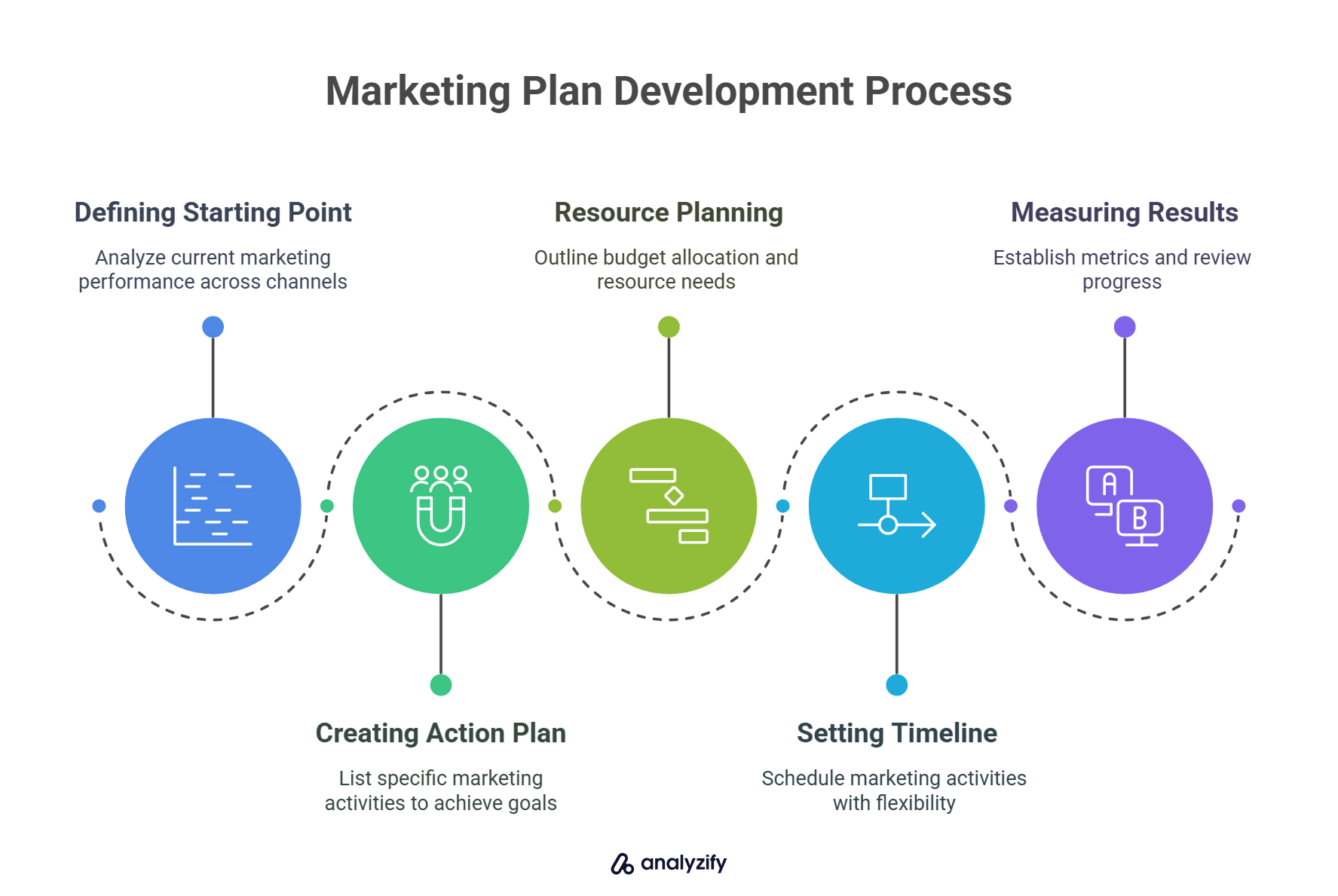
Defining Your Starting Point
Your marketing plan must start with a clear picture of your current situation. Look at your existing marketing performance across all channels. Dig into the numbers behind your website traffic, sales from each channel, customer feedback, and campaign results. This information helps you identify what’s working, what isn’t, and where the best opportunities lie.
Beyond just gathering data, analyze what these numbers mean for your business. For instance, if your data shows email marketing drives 60% of your sales while social media accounts for only 10%, you might plan to invest more heavily in email campaigns while testing new approaches to social media.
Creating Your Action Plan
List specific marketing activities you’ll undertake to achieve your goals. Each activity should include clear details about execution.
For example, instead of simply stating “increase email marketing,” your plan might specify:
- Send weekly newsletter highlighting new products and customer success stories
- Create three-part welcome series for new subscribers
- Develop seasonal promotion campaigns for major holidays
- Test subject lines and send times to improve open rates
Resource Planning
Marketing activities require specific resources to succeed. Your plan needs to outline exactly what you need and how you’ll use it. Start by mapping out your budget allocation across different activities.
A detailed resource plan includes:
- Team members involved and their time commitments
- Content creation needs and costs
- Advertising budgets by channel
- Required tools and software
- External resources or contractors needed
Setting Your Timeline
Create a detailed schedule showing when each marketing activity will happen. Your timeline should account for preparation time, execution, and measurement periods. Build in flexibility for adjustments based on results.
Break your timeline into quarterly objectives with monthly milestones. This approach lets you track progress while maintaining flexibility to adapt to changing market conditions or new opportunities.
Measuring Results
Establish clear methods for tracking your plan’s effectiveness. Define specific metrics that show progress toward your goals. Instead of vague targets like “increase engagement,” set specific goals like “achieve 25% email click-through rate on product announcement campaigns.”
Review your metrics monthly to understand:
- Which activities are driving the best results
- Where you need to make adjustments
- How results compare to your targets
- What changes might improve performance
Remember that your marketing plan should evolve based on what you learn. Schedule quarterly reviews to assess overall progress and make larger adjustments to your approach when needed.
5) Marketing Playbook
A marketing playbook documents your organization’s standard marketing processes, guidelines, and best practices. Think of it as your company’s marketing manual - showing exactly how to execute different types of marketing activities consistently and effectively.
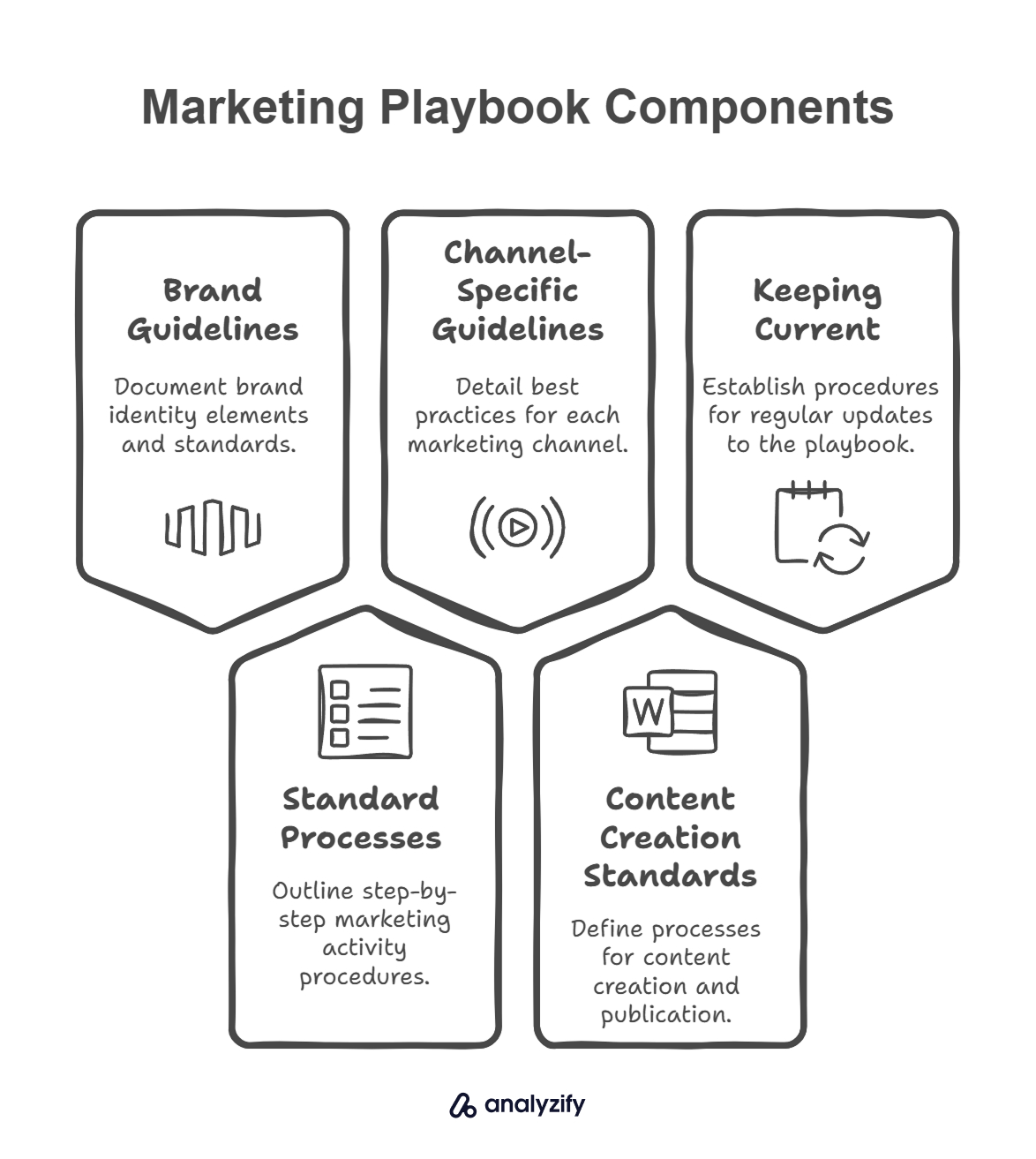
Purpose and Function
Unlike a marketing plan that outlines specific campaigns, a playbook serves as a reference guide that any team member can use to understand how marketing should be done at your organization.
It captures proven approaches and learned lessons, making it easier to maintain quality as teams grow or change.
When properly created, your marketing playbook helps new team members get up to speed quickly and ensures everyone follows the same standards.
For example, when launching an email campaign, team members can refer to the playbook for guidance on everything from writing subject lines to scheduling send times.
Essential Components of Marketing Playbook
Your marketing playbook needs several key sections to serve as a complete reference guide for your team. Each component below provides specific guidance for different aspects of your marketing execution.
Brand Guidelines
Your playbook must clearly document how to present your brand across all channels. This section should explain:
The core elements of your brand identity, including:
- Voice and tone for different types of communication
- Visual standards like colors, fonts, and logo usage
- Writing style and common phrases
- Photography and image guidelines
Standard Processes
Document step-by-step procedures for common marketing activities. Rather than just listing steps, explain the reasoning behind each process. For instance, when outlining social media posting procedures, explain why certain post types work best at specific times.
Channel-Specific Guidelines
Each marketing channel needs its own detailed section explaining best practices and procedures. For email marketing, you might include:
“Send promotional emails between 10am and 2pm on Tuesdays or Thursdays when data shows our audience is most engaged. Test subject lines with a small segment before sending to the full list.”
Content Creation Standards
Outline how different types of content should be created, reviewed, and published. Include:
- Content planning processes
- Writing and editing guidelines
- Review and approval workflows
- Publishing checklists
Keeping Your Playbook Current
Your playbook should evolve as you learn what works best. Set up quarterly reviews to update procedures based on:
- Performance data from recent campaigns
- New tools or technologies adopted
- Changes in market conditions
- Team feedback on processes
Remember that a playbook is only valuable if teams actually use it. Make it easily accessible and encourage team members to reference it regularly. Consider creating quick-reference versions for commonly used processes.
6) Marketing Guidelines
Marketing guidelines create consistency in how your brand appears and communicates across all channels. These guidelines act as the rulebook for your brand identity, ensuring everyone who creates marketing materials maintains the same standards and quality.

Understanding Brand Identity Standards
Your brand needs to look and sound the same everywhere customers encounter it. Imagine a customer moving from your Instagram page to your website to your email newsletter - they should instantly recognize your brand at each step through consistent visuals and messaging.
These standards start with your visual identity. Define exact specifications for your logo use, showing teams when to use different versions and how much space to maintain around it. Create a clear color palette with specific color codes for print and digital use, explaining which colors work together and how to use them effectively.
Key visual elements to standardize include:
- Logo usage and placement rules
- Brand color specifications
- Typography requirements
- Image style guidelines
Creating a Consistent Voice
Your brand voice gives personality to your marketing. Document how your brand should sound in different situations, from social media posts to customer service emails. Include real examples showing how to adapt your tone while maintaining your core brand voice.
For instance, your guidelines might specify: “Our brand voice is friendly and helpful, but never casual. We use industry terms when needed but explain them clearly. We avoid jargon and complicated language.”
Channel-Specific Requirements
Different marketing channels need specific guidelines. Your social media posts might use a more conversational tone than your white papers, but both should clearly represent your brand.
Create detailed standards for each channel that show:
- Appropriate content types
- Format requirements
- Best practices
- Common mistakes to avoid
Implementing Your Guidelines
Guidelines only work when teams actually use them. Make your guidelines accessible and easy to understand through:
Clear examples of correct and incorrect usage Templates for common marketing materials Checklists for reviewing work Regular training on guideline updates
Remember to review and update your guidelines periodically. As your brand evolves and new marketing channels emerge, your guidelines should adapt while maintaining your core brand standards.
7) Customer Personas
Customer personas transform customer data into detailed profiles that represent your ideal customers. Instead of marketing to a vague audience, personas help you understand and connect with specific types of customers who are most likely to value your products or services.
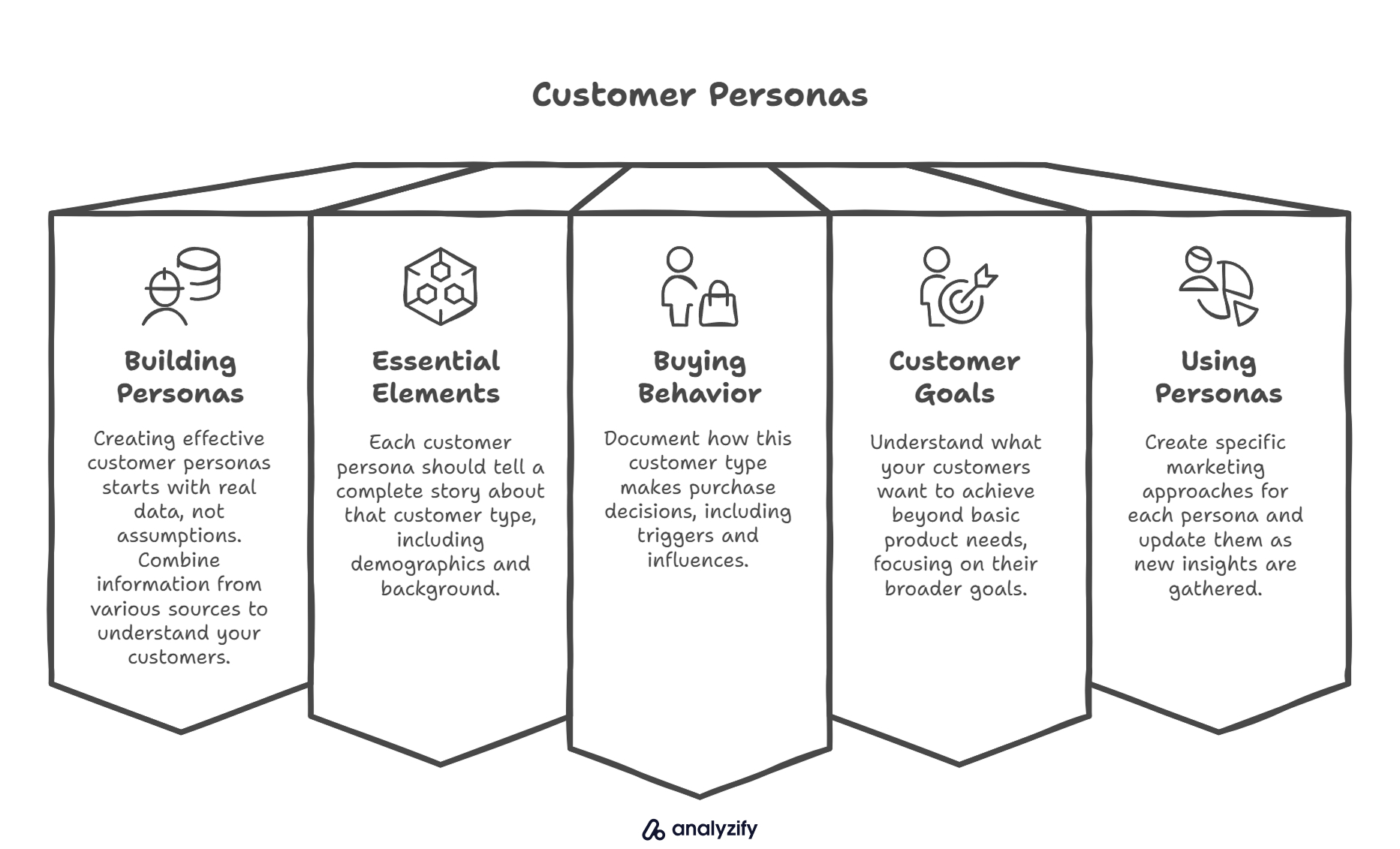
Building Accurate Personas
Creating effective customer personas starts with real data, not assumptions. Combine information from customer interviews, surveys, sales data, and website analytics to understand who your customers really are and what drives their decisions.
For example, instead of assuming young professionals want the cheapest option, your research might reveal they prioritize convenience and are willing to pay more for products that save them time. This insight changes how you market to them.
Essential Persona Elements
Each customer persona should tell a complete story about that customer type. Include details that matter for marketing decisions, such as:
Demographics and Background
- Job role and career path
- Income level and spending habits
- Family situation and lifestyle
- Daily routines and challenges
Buying Behavior
Document how this customer type makes purchase decisions. Include specific details like:
- What triggers their need for your product
- How they research options
- Who influences their decisions
- What might stop them from buying
Understanding Customer Goals
Dive deep into what your customers want to achieve. Look beyond basic product needs to understand their broader goals and challenges.
For instance, someone buying accounting software isn’t just looking for a way to track numbers - they might be trying to:
- Reduce time spent on bookkeeping
- Avoid tax filing mistakes
- Understand their business performance better
- Plan for business growth
Using Personas Effectively
Create specific marketing approaches for each persona. Show how to:
- Write content that addresses their specific concerns
- Choose marketing channels where they spend time
- Develop offers that appeal to their priorities
- Speak in language that resonates with them
Remember to update your personas as you gather new customer insights. Customer needs and behaviors change over time, and your personas should reflect these changes.
8) Social Media Content Calendar
A social media content calendar maps out when and what you’ll post across your social media channels. Unlike random posting when you have time, a content calendar ensures you consistently share content that serves specific marketing purposes.
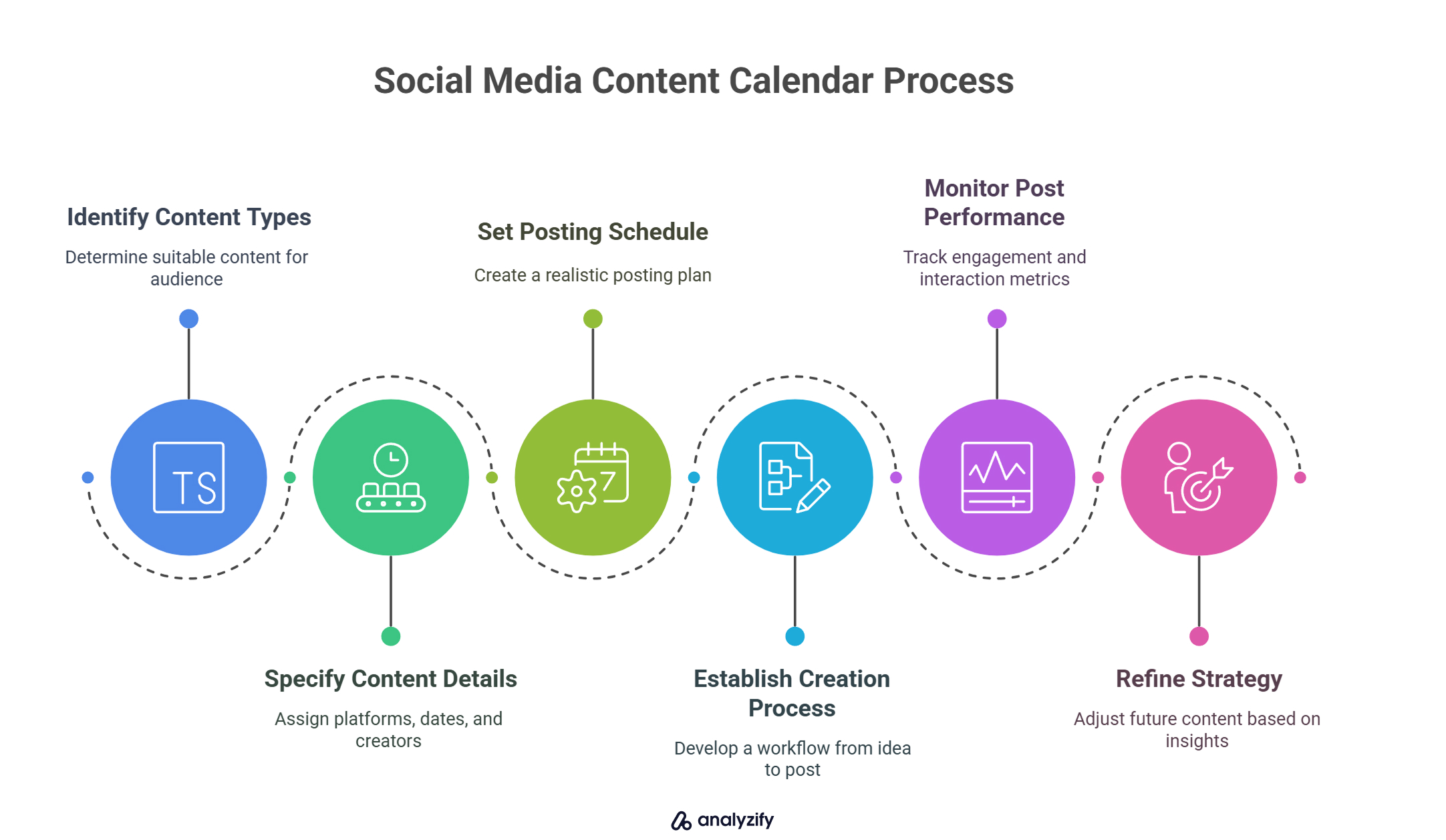
Planning Your Social Content
Your social media content needs clear organization by platform, timing, and purpose. Build your calendar by first determining what types of content will connect with your audience.
A retail brand might share a mix of product photos, styling tips, customer features, and seasonal trend updates.
A B2B company might focus on industry insights, client success stories, and educational content about their services.
For each piece of content, specify:
- Which platform it will appear on
- The exact date and time for posting
- Who will create the content
- Who needs to approve it
- What visuals or assets are needed
Setting Up Your Posting Schedule
Create a realistic posting schedule based on your team’s capacity and content quality standards. Posting three times per week with valuable, engaging content works better than daily posts that lack substance.
Consider how different content types work on each platform. For example: Educational content might perform best on LinkedIn during business hours Behind-the-scenes content often engages well on Instagram Stories Quick tips and updates can work throughout the day on Twitter
Content Creation and Management
Establish a clear process for moving content from idea to published post. Start by planning content themes for each month. Then break these themes into specific posts, considering how they’ll work together to tell a cohesive story about your brand.
Your content mix should include:
- Educational posts that solve customer problems
- Engaging content that starts conversations
- Product or service highlights that show clear benefits
- Community-building posts that showcase your brand personality
Tracking What Works
Monitor how different types of posts perform with your audience. Look at:
- Which topics generate the most engagement
- What times of day see highest interaction
- Which content types drive the most clicks or saves
- How seasonal factors affect post performance
Use these insights to refine your future content calendar. Adjust your posting schedule, content mix, and themes based on what resonates most with your audience.
Social Media Timing Resources
For maximizing engagement on your social media content calendar, check these up-to-date guides on optimal posting times:
- Guide To Best Times To Post On YouTube in 2025
- Guide To Best Times to Post on Facebook in 2025
- Guide to Best Times to Post on Instagram in 2025
- Guide To Best Times to Post on TikTok in 2025
9) Market Analysis
A market analysis document evaluates your total market size, customer needs, and direct competition to shape your marketing and business decisions. Create this document before launching new products or entering new markets, then update it annually to reflect current conditions.
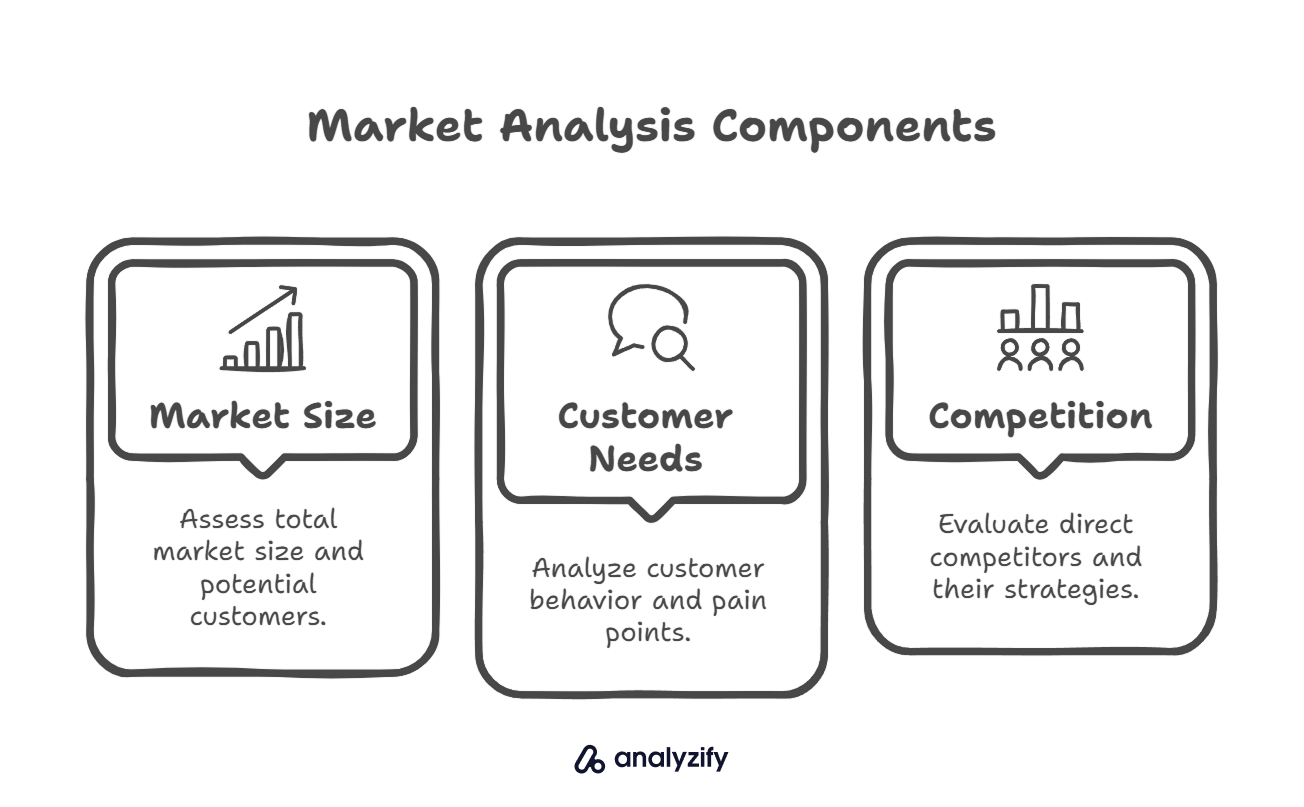
Market Size Assessment
Start by determining your total market size using verifiable data sources. Calculate both the total market value in currency and the number of potential customers. Then narrow these numbers down to your serviceable market - the portion you can realistically reach and serve.
Document these foundational metrics:
- Annual market value in your target regions
- Year-over-year market growth rate
- Share of market you can realistically serve
Customer Needs Analysis
Study actual customer behavior through surveys, interviews, and purchase data. Focus on understanding what drives purchase decisions rather than making assumptions. Document specific pain points customers face and how they currently solve these problems.
Capture these vital customer insights:
- Primary problems customers need to solve
- Current solutions they use and their limitations
- Key factors that trigger purchase decisions
Competition Evaluation
Study direct competitors who target the same customers you do. Document their specific offerings, how they position themselves, and where they succeed or fall short. Focus on gathering concrete data rather than making assumptions about their business.
Track these essential details:
- Market share percentages of major competitors
- Their pricing strategies and typical discounts
- Distribution channels they use effectively
End your analysis with specific, data-backed recommendations for action. State exactly what your findings mean for your marketing strategy and which opportunities offer the highest potential return based on your research.
10) Email Newsletter Template
An email newsletter template ensures your newsletters maintain consistent design and structure across all sends. A well-designed template combines both text and visuals to drive subscriber engagement, with properly spaced sections that guide readers through your content.
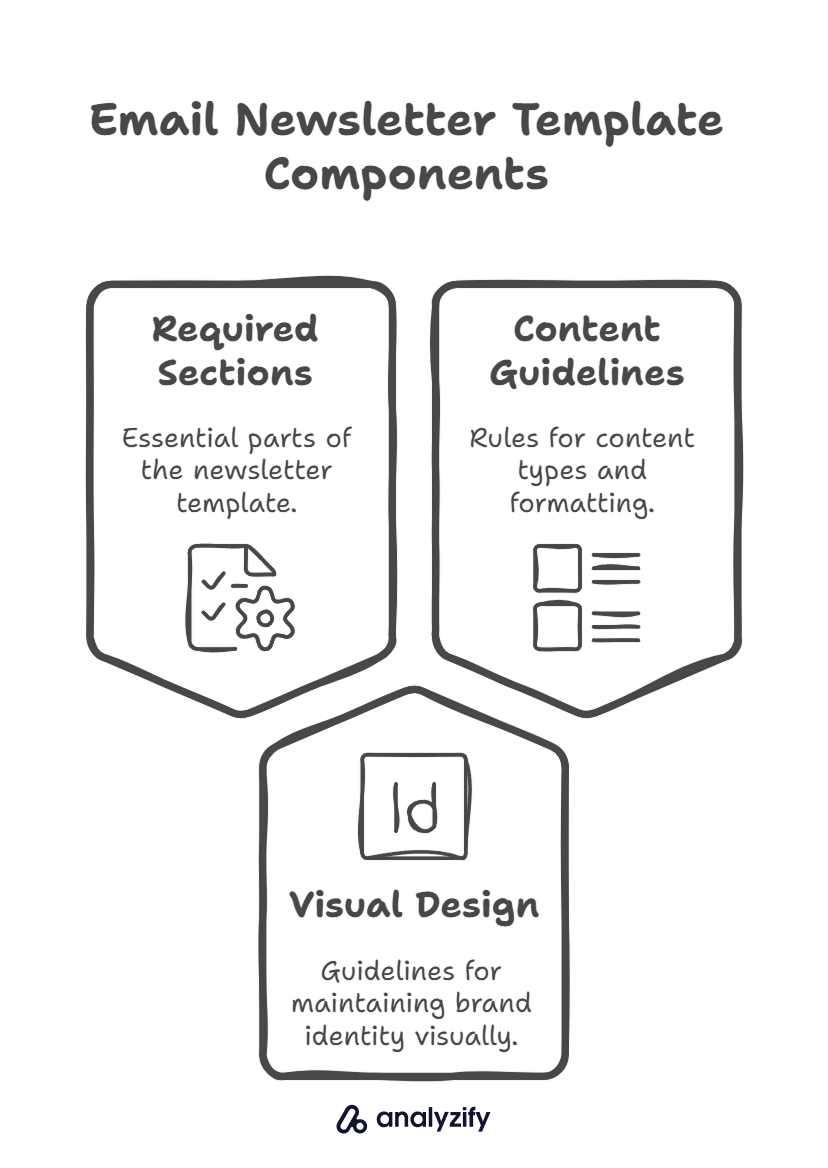
Required Template Sections
Your newsletter template must establish clear visual hierarchy through properly organized content blocks. Start with a powerful subject line and preview text that appears in subscribers’ inboxes. The main body should contain distinct sections for different content types, each with clear headings and appropriate spacing.
These foundational elements must be present:
- Header with your brand logo and recognizable design
- Primary content area with flexible layout options
- Clear navigation between content sections
Visual Design Elements
The template’s design must reflect your brand identity while remaining readable across all devices. Define exact spacing measurements between elements to maintain visual harmony. Select fonts that remain legible at various sizes and on different screens.
Set standards for these visual components:
- Typography choices for different content types
- Image placement and sizing requirements
- White space allocation between sections
Content Guidelines
Create specific rules for the types of content that belong in each template section. Define word count ranges that ensure readability while maintaining engagement. Document exactly how different content types should be formatted, from feature articles to promotional offers.
Your template should specify:
- Word count limits for each section
- Image requirements including file types and sizes
- Formatting standards for different content categories
Review and test your template regularly using different email clients and devices to ensure it continues to perform as intended.
Email Marketing Timing Resource
To ensure your email newsletters reach subscribers when they’re most likely to engage:
The Most Important Marketing Documents: Final Words
Building a foundation of well-documented marketing processes pays off in measurable results - from faster campaign execution to more consistent brand messaging. Yet documentation only works when it’s clear, actionable, and regularly maintained. Start with the essential documents outlined above, but remember they should evolve alongside your marketing needs and business goals.
Marketing Documentation: Frequently Asked Questions
Here are the most common questions marketers ask about creating and maintaining essential marketing documents:
What’s the difference between a marketing strategy and a marketing plan?
A marketing strategy outlines what you want to achieve and why, focusing on high-level goals and approaches. A marketing plan details exactly how you’ll execute that strategy, including specific tactics, timelines, and resources needed.
How long should a marketing proposal be?
Marketing proposals should be 10-15 pages maximum. Research shows proposals over 20 pages see a 35% lower success rate than those kept under 10 pages. Focus on clarity and specifics rather than length.
Should marketing objectives be quarterly or annual?
Set annual marketing objectives with quarterly milestones. This provides long-term direction while allowing regular progress checks and adjustments. Your primary metrics should have both annual targets and quarterly benchmarks.
How often should you update your marketing playbook?
Review and update your marketing playbook quarterly. Schedule updates to coincide with performance reviews so you can incorporate learnings from recent campaigns. Make immediate updates for major process changes or new marketing channels.
Do you need separate social media content calendars for each platform?
Maintain one master calendar that includes all platforms but clearly distinguishes between them. This helps you coordinate messaging across channels while respecting the unique requirements and best practices of each platform.
What’s the difference between marketing guidelines and a marketing playbook?
Marketing guidelines focus specifically on brand standards and rules for creating marketing materials. A marketing playbook is more comprehensive, covering processes, workflows, and best practices for executing all marketing activities.
Who should be responsible for maintaining marketing documentation?
Assign a primary owner (usually a marketing manager or director) to oversee documentation, but make updates collaborative. Create a system where team members can suggest changes based on their direct experience using the documents.
How detailed should brand guidelines be for a small business?
Even small businesses need comprehensive brand guidelines covering logo usage, colors, typography, voice, and basic design rules. Start with these essentials and expand as your marketing needs grow.
When should you create a new marketing document vs. updating existing ones?
Create new documents when:
- Launching entirely new marketing channels or strategies
- Current documentation no longer reflects your core processes
- Team feedback indicates major gaps in existing documents
Update existing documents when:
- Making incremental improvements to current processes
- Adding new sections to cover expanded capabilities
- Refining guidelines based on performance data
What are the must-have sections in a marketing proposal?
Every marketing proposal needs:
- Executive summary (1 page)
- Project understanding and objectives
- Detailed solution/approach
- Timeline and deliverables
- Team and resources
- Budget breakdown
- Expected results and KPIs
- Terms and conditions

































